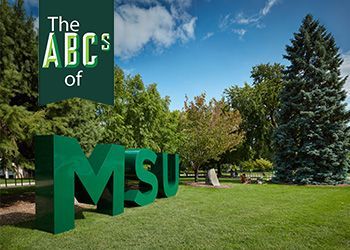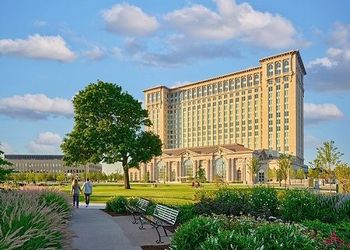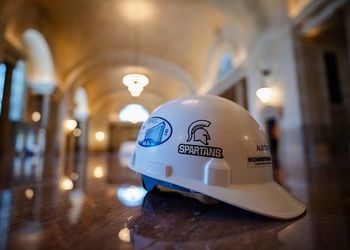Feature: Beaumont Tower

AT THE CROSSROADS OF PAST, PRESENT & FUTURE
In the 67 years of its existence, the John W. Beaumont Memorial Tower has come to mean many things to many people. Located at the center of campus life, it has stood in mute relation to all the activities that have taken place in its benign shadow. As a result, each person who looks at or remembers Beaumont Tower will be aware of slightly different meanings and associations in connection with it, and this has given the tower an unusually personal attraction.
Even more intriguing, however, are the additional meanings that were built into the tower by its designers and planners. These meanings have a way of registering subliminally on our thoughts, affecting our feelings and outlook in ways we may not realize. It is the combination of conscious and unconscious associations which is responsible for the tremendous power and appeal of Beaumont Tower as a campus symbol. With the completion of the tower's restoration, a project approved by the MSU Board of Trustees, it is fitting to examine and appreciate the sources of its enduring charm and influence.
HISTORICAL BACKGROUND
The history of Beaumont Tower is inextricably tied to the history of MSU campus and the evolution of its self-concept. Few people who walk or bike across the broad, green expanses of Campus Circle ever stop to think how strange it is that so large an area of otherwise busy campus should remain relatively undeveloped. It has not remained so by accident.
Beaumont Tower, unbeknownst to many, played a major part in the preservation of the Campus Circle as an open area. How did the tower come to be in the spot where it stands today? Interestingly, Beaumont Tower now stands at what was once the northeast corner of College Hall, not only the first instructional building to be erected on the MSU campus, but the first building in the United States to be devoted entirely to the teaching of scientific agriculture. College Hall was the birthplace of the entire land-grant system. Designed with state-of-the-art features, the new building was intended to facilitate a novel form of education previously unheard of in the sublimely detached colleges of the East--'the application of modern science to the practical business of life.'
In this unique place, professors and students taught, studied, experimented, and even prayed, using the chemistry lecture room as a makeshift chapel. Given its extensive use and the wide range of its functions, College Hall soon became an object of great fondness. Those who taught and studied there were keenly aware that they were pioneers in a grand educational experiment. For the first time anywhere in the country, working-class students were being treated with respect and educated with the expectation that they would go on to positions of leadership--in agriculture, in business, in government, and in education. College Hall, then, for many students, was the gateway to a better life.
Accordingly, around the turn of the century, plans were made to renovate College Hall completely and preserve it as a Student Union. Workers, however, were soon dismayed to discover serious structural problems in the building. Renovation was immediately halted and shorings were put in place to hold up weakened sections. Then, on one fateful night in 1918, two walls of College Hall collapsed. The building that had been the birthplace of the land-grant ideal, the heart and soul of MAC, was in ruins. Despite every attempt to save it, the grand old hall was destined to vanish forever from the college landscape. One former student, however, was determined that College Hall, would not vanish from campus memory.
John W. Beaumont, who had graduated in 1882 and gone on to become a successful Detroit lawyer, conceived the idea of a monument. What he wanted was not a mere plaque or stone marker, but something that would stand as a fitting tribute to College Hall and to the courageous and dedicated teachers who had worked there to change so many lives. Subsequently, Beaumont, conferring with MSC, the Board of Agriculture, and the Alumni Association, decided on the idea of a tower.
As The Agricultural College Record reported, Beaumont hoped that the proposed tower 'might take such outward form as to fittingly supplement the charm and beauty of its peaceful setting, that its chime of mellow bells and the sculptured `Sower' over its entrance might perhaps echo in some modest way something of the inspiration that came to him . . . through the lives and words of his teachers.'
The sculpture of the sower mentioned by Beaumont was to be a point of particular interest. The Art Deco bas-relief by Lee Lawrie (1922), with its inscription, 'Whatsoever a Man Soweth,' would pay tribute to those early professors whose faith in humanity had moved them to sow knowledge in what was once thought to be stony ground. It would also serve as an admonition to future educators to teach wisely, and an encouragement to students to pass on what they had learned. The obvious symbolism of the relief, would not only celebrate the college's agricultural roots, but suggest the vital connection between knowledge and survival. We prosper as we teach.
Beaumont Tower, then, was designed to be a monument to teaching. It was also, however, meant to serve as a kind of fortification. Built in the Collegiate Gothic style, the tower not only contained the spiritual elements embodied in the chapel-like base and cathedral-like crown, but the crenelations and lancet windows of a fortress. This combination of spiritual and martial design elements can be attributed partially to a romantic idealism, to the battle against ignorance and social inequality, or to the 'muscular Christianity' that then informed all aspects of professional life, including scholarship.
In a more literal sense, however, Beaumont Tower really was meant to function as a defensive structure. With the collapse of College Hall in 1918 and the burning of two adjacent dormitories, Campus Circle, now devoid of buildings, became vunerable to new development. An artillery garage was built on the foundations of College Hall, and plans were made to cover Campus Circle with a circle of new buildings. The MSC alumni, wanting to preserve the area as a 'sacred space,' initiated a 'Save the Circle' campaign, and John W. Beaumont presented his plan to replace the artillery garage with a memorial tower. This tower, occupying the highest end of the circle, would dominate the skyline of the north campus and discourage future building in the oldest and most historical sections of the college.
MEANINGS AND FUNCTIONS OF THE TOWER
The construction of Beaumont Tower was completed in 1928, and the dedication took place in June of 1929. We are fortunate that the dedicatory words of MSC President Robert S. Shaw were recorded in The Agricultural College Record, for they give us unusual insight into the entire range of the tower's intended functions, from the most mundane to most sublime. They also reveal the intelligence, piety and vision of all those who were involved in its creation.
The first function of Beaumont Tower, according to President Shaw, was entirely practical--its function as a timepiece. 'The institution has grown to quite large proportions,' he observed, 'and this tower, with its chimes will be the one factor on campus that will daily and hourly direct the movements and activities of more than three thousand students and a very large faculty.' These movements had originally been directed by the 'lone, crude, cast-iron bell...which jingled at the end of each hour,' a sound which for Shaw and countless others had great nostalgic appeal.



